
Ulmus 'San Zanobi' is a hybrid elm cultivar raised by the Istituto per la Protezione delle Piante (IPP) in Florence, from a crossing of the Dutch hybrid 'Plantyn' and the Siberian Elm Ulmus pumila clone 'S 15'; it was released to commerce in 2002. 'San Zanobi' was introduced to the UK in 2004 by Hampshire & Isle of Wight Branch, Butterfly Conservation, as part of its assessment of DED-resistant cultivars as potential hosts of the endangered White-letter Hairstreak.

Ulmus davidiana var. japonica, the Japanese elm, is one of the larger and more graceful Asiatic elms, endemic to much of continental northeast Asia and Japan, where it grows in swamp forest on young alluvial soils, although much of this habitat has now been lost to intensive rice cultivation.

Ulmus 'Nanguen' is a complex fourth generation Dutch hybrid cultivar raised at the Dorschkamp Research Institute for Forestry & Landscape Planning, Wageningen. Lutèce was derived from the cross 'Plantyn' ×, an ancestry comprising four field elms, a wych elm, the curious Exeter Elm ('Exoniensis'), and a frost-resistant selection of the Himalayan elm.

Ulmus 'New Horizon' is an American hybrid cultivar raised by the Wisconsin Alumni Research Foundation (WARF), from a crossing of the Japanese Elm clone W43-8 = 'Reseda' with Siberian Elm clone W426 grown from seed collected from a street tree at Yankton, South Dakota. As selection 'W917' it is a sibling of 'Rebona'. Tested in the US National Elm Trial coordinated by Colorado State University, 'New Horizon' averaged a survival rate of 74% after 10 years. 'New Horizon' was patented in the US in 1994, while in Europe, it is marketed as one of the 'Resista' elms protected under EU breeders' rights.

Ulmus 'Clusius' is a Dutch hybrid elm cultivar raised at the Dorschkamp Research Institute for Forestry & Landscape Planning, Wageningen, and released to commerce in 1983. 'Clusius' was derived from a crossing of the same Dutch clones that produced the fastigiate 'Lobel' released in 1973: '202' and '336'.
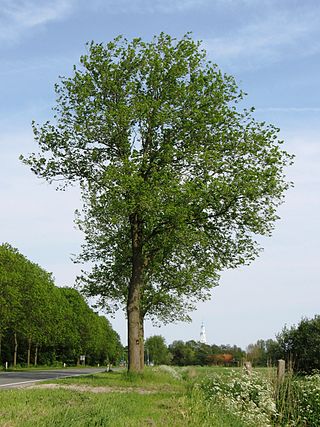
Ulmus × hollandica 'Commelin' is a Dutch hybrid cultivar released for sale in 1960. The tree was raised at Baarn as clone 274 by the Foundation Willie Commelin Scholten Phytopathological Laboratory in 1940, from a crossing of Ulmus × hollandica 'Vegeta' and clone 1, an Ulmus minor selected from a 1929 elm seedlings lot obtained from the Barbier nursery, Orléans.

The Dutch hybrid cultivar Ulmus 'Dodoens' was derived from a selfed seedling of a crossing of the Exeter Elm Ulmus 'Exoniensis' with the Himalayan Elm Ulmus wallichiana at the Dorschkamp Research Institute for Forestry & Landscape Planning, Wageningen. The tree was one of several cultivars prepared for release in 1970, but delayed by the outbreak of the second, far more aggressive strain of Dutch elm disease.

The Dutch hybrid elm cultivar Ulmus × hollandica 'Groeneveld' was cloned in 1949 at the De Dorschkamp Institute, Wageningen, and released in 1963 in response to the earlier, less virulent form of Dutch elm disease that afflicted Europe shortly after the First World War. The cultivar was derived from a crossing of Dutch clones '49', and '1', a Field Elm Ulmus minor found in central France and marketed by the Barbier nursery in Orléans.

Ulmus 'Homestead' is an American hybrid elm cultivar raised by Alden Townsend of the United States National Arboretum at the Nursery Crops Laboratory in Delaware, Ohio. The cultivar arose from a 1970 crossing of the Siberian Elm Ulmus pumila with the hybrid N 215, the latter grown from seed sent in 1960 to the University of Wisconsin-Madison elm breeding team by Hans Heybroek of the De Dorschkamp Research Institute in the Netherlands. Tested in the US National Elm Trial coordinated by Colorado State University, 'Homestead' averaged a survival rate of 85% after 10 years. 'Homestead' was released to commerce without patent restrictions in 1984.

Ulmus × hollandicaMill. , often known simply as Dutch elm, is a natural hybrid between Wych elm and field elm Ulmus minor which commonly occurs across Europe wherever the ranges of the parent species overlap. In England, according to the field-studies of R. H. Richens, "The largest area [of hybridization] is a band extending across Essex from the Hertfordshire border to southern Suffolk. The next largest is in northern Bedfordshire and adjoining parts of Northamptonshire. Comparable zones occur in Picardy and Cotentin in northern France". Crosses between U. × hollandica and either of the parent species are also classified as U. × hollandica. Ulmus × hollandica hybrids, natural and artificial, have been widely planted elsewhere.
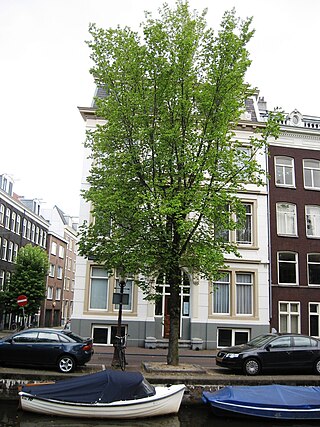
Ulmus 'Plantyn' was one of three Dutch hybrid elms released by the Dorschkamp Research Institute for Forestry & Landscape Planning, Wageningen, in 1973. Derived from a crossing of the Dutch hybrids '202' and '302', it was to prove of great significance in later developments. A selfed seedling was to become the first Dutch clone to prove effectively immune to disease, released in 1989 as 'Columella'. 'Plantyn' was also destined to be the female parent of Lutèce released in 2002. In Italy, 'Plantyn' was used again as female parent in hybridizations with the Siberian Elm Ulmus pumila by the Istituto per la Protezione delle Piante (IPP), to create three new cultivars better adapted to the Mediterranean climate.
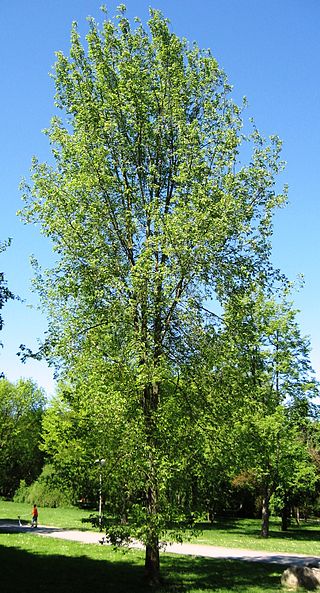
Ulmus 'Regal' is an American hybrid elm cultivar developed by the University of Wisconsin–Madison and released in 1983. 'Regal' was derived from seeds arising from the crossing of the Dutch hybrid clones 'Commelin' and '215' sent in 1960 by Hans M. Heybroek of the Dorschkamp Research Institute for Forestry & Landscape Planning, Wageningen, Netherlands.
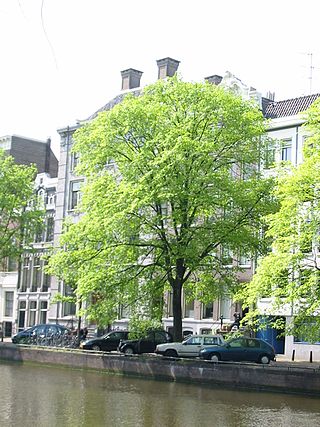
The hybrid elm cultivar Ulmus × hollandica 'Belgica', one of a number of hybrids arising from the crossing of Wych Elm with a variety of Field Elm, was reputedly raised in the nurseries of the Abbey of the Dunes, Veurne, in 1694. Popular throughout Belgium and the Netherlands in the 19th century both as an ornamental and as a shelter-belt tree, it was the 'Hollandse iep' in these countries, as distinct from the tree known as 'Dutch Elm' in Great Britain and Ireland since the 17th century: Ulmus × hollandica 'Major'. In Francophone Belgium it was known as orme gras de Malines.

Ulmus 'Columella' is a Dutch elm cultivar raised by the Dorschkamp Research Institute for Forestry & Landscape Planning, Wageningen. Originally thought to have been derived from a selfed or openly pollinated seedling of the hybrid clone 'Plantyn', DNA analysis later determined it arose from a cross of 'Plantyn' and Ulmus minor. Sown in 1967, it was released for sale in 1989 after proving extremely resistant to Dutch elm disease following injection with unnaturally high doses of the pathogen, Ophiostoma novo-ulmi. However, propagated by grafting onto wych elm rootstocks, graft failure owing to incompatibility has become a common occurrence in the Netherlands.

Ulmus 'Cathedral' is a hybrid cultivar raised at University of Wisconsin–Madison patented in 1994. Arising from a chance crossing of the Japanese elm and Siberian elm, seed was sent in 1958 by Prof. Nobuku Takahashi and his colleagues at the Sapporo Botanical Garden of Hokkaido University, Sapporo, to Eugene Smalley at Wisconsin–Madison; 'Cathedral' is thus a sibling of 'Sapporo Autumn Gold'.

The elm cultivar Ulmus minor 'Bea Schwarz' was cloned at Wageningen in the Netherlands, by the elm disease committee, from a selection of Ulmus minor found in France in 1939. However, specimens of the tree grown in the UK and the United States are falsely treated as Ulmus × hollandica.

The hybrid elm cultivar Ulmus 'Den Haag' is a Dutch development derived from a chance crossing of the Siberian Elm cultivar Ulmus pumila 'Pinnato-ramosa' and the Belgian Elm Ulmus × hollandica 'Belgica'. S. G. A. Doorenbos (1891-1980), Director of Public Parks in The Hague, finding that seeds he had sown in 1936 from the Zuiderpark 'Pinnato-ramosa' had hybridized with the local 'Belgica', selected six for trials. The best was cloned and grafted on 'Belgica' rootstock as 'Den Haag'; it was planted first in that city, then released to nurseries elsewhere in the Netherlands. The other five were also planted in The Hague.

Ulmus 'Fiorente' is a hybrid cultivar elm derived from a crossing of the Siberian Elm Ulmus pumila clone 'S.10' from Lucca, Italy, with the Ulmus minor clone 'C.02' from Lungarno, Florence, by the Istituto per la Protezione delle Piante (IPP), part of the Italian National Research Council, in Florence. The tree is protected by Plant Breeders' Rights bestowed by the EU on 25 March 2010.
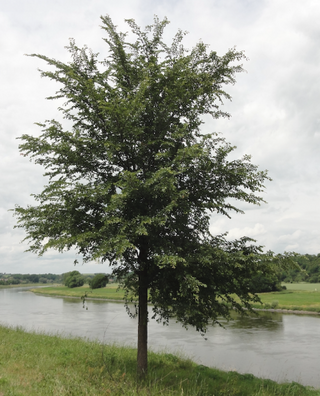
The Field Elm cultivar Ulmus minor 'Reverti' is a University of Wisconsin–Madison selection, registered and named in Germany in 1993 by Conrad Appel, Darmstadt.

Ulmus 'Rebella' is an American hybrid cultivar elm raised from a rare crossing of the Chinese Elm U. parvifolia and the American Elm U. americana by Smalley and Guries of the Wisconsin Alumni Research Foundation in 1987 as clone 2245-9. Grown under licence by Eisele GmbH, Darmstadt, Germany, 'Rebella' was released to commerce in Europe in 2011.

























